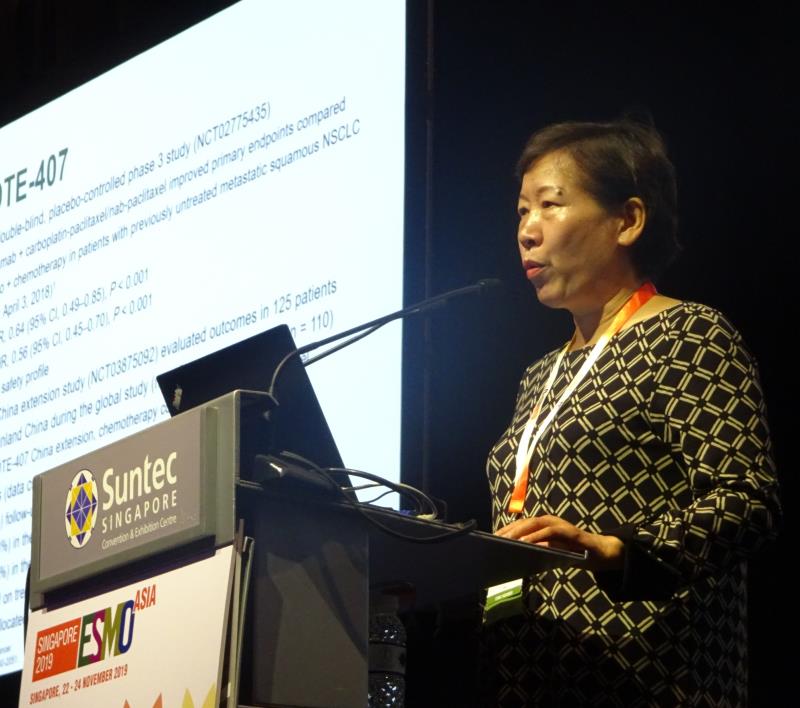 Dr Cheng Ying
Dr Cheng YingAdding pembrolizumab to platinum-based chemotherapy significantly improved survival and response to treatment compared with chemotherapy alone in the first-line setting for Chinese patients with metastatic, squamous non–small-cell lung cancer (NSCLC), according to the KEYNOTE-407* China Extension Study presented at the ESMO Asia 2019 Congress.
“These data are consistent with findings from the global study and support [the] use of pembrolizumab + carboplatin and paclitaxel as a new standard of care for previously untreated metastatic squamous NSCLC in China,” said Dr Cheng Ying from Jilin Cancer Hospital, Changchun, China.
In the global KEYNOTE-407 study, the addition of pembrolizumab to carboplatin plus paclitaxel/nab-paclitaxel significantly extended overall survival (OS; hazard ratio [HR], 0.71, 95 percent confidence interval [CI], 0.58–0.88) and progression-free survival (PFS; HR, 0.57, 95 percent CI, 0.47–0.69) in patients with previously untreated metastatic NSCLC, as previously presented in the ESMO 2019 Congress in Barcelona, Spain. [ESMO 2019, abstract LBA852]
Consistent with the results in the global population, Chinese patients treated with pembrolizumab in addition to carboplatin + paclitaxel had significantly longer OS (median, 17.3 vs 12.6 months; HR, 0.44, 95 percent CI, 0.24–0.81) compared with those who received chemotherapy alone, after a median follow-up of 10.4 months in the China Extension Study. [ESMO Asia 2019, abstract LBA20]
OS benefit was observed across patient subgroups, regardless of age, sex, ECOG performance status, and PD-L1 tumour proportion score.
Similarly, the addition of pembrolizumab almost doubled the median PFS (8.3 vs 4.2 months), with the risk of disease progression or death more than halved compared with chemotherapy alone (HR, 0.32, 95 percent CI, 0.21–0.49).
The objective response rate (ORR) was also improved by 36.8 percent with pembrolizumab addition vs chemotherapy alone (78.5 percent vs 41.7 percent) in the Chinese population, similar to the rates observed in the global population (difference, 24.1 percent; ORR, 62.6 percent vs 38.4 percent).
Median duration of response was 8.9 months in the pembrolizumab + chemotherapy arm vs 3.5 months in the chemotherapy alone arm — which again, was consistent with that observed in the global population (median, 8.8 vs 4.9 months).
“The safety profile of pembrolizumab plus chemotherapy was manageable, with no new safety signals identified in this Chinese patient population,” said Cheng.
The incidence of grade 3–5 adverse events (AEs) was 89 percent and 87 percent in the pembrolizumab + chemotherapy and the chemotherapy alone arms, respectively. Immune-mediated AEs and infusion reactions were reported in 29 percent in the pembrolizumab + chemotherapy arm compared with 10 percent in the chemotherapy alone arm, with grade 1–2 hyper- and hypothyroidism being the most common in the pembrolizumab arm.
The China Extension Study involved 125 patients (of which 15 were from the global KEYNOTE-407 trial; median age 63 years, 95 percent male) with metastatic squamous NSCLC from mainland China. Patients were randomized 1:1 to receive pembrolizumab or placebo for 35 cycles, both in addition to four cycles of carboplatin + paclitaxel.
Based on these results, the China’s National Medical Products Administration has approved pembrolizumab + carboplatin/paclitaxel for the treatment of metastatic squamous NSCLC in the first-line setting in China.